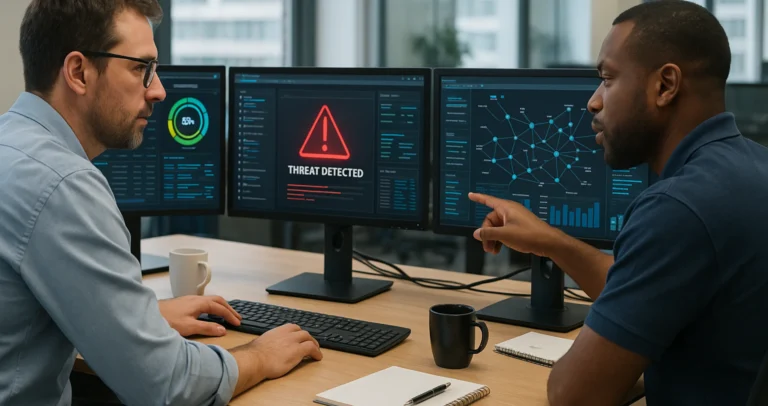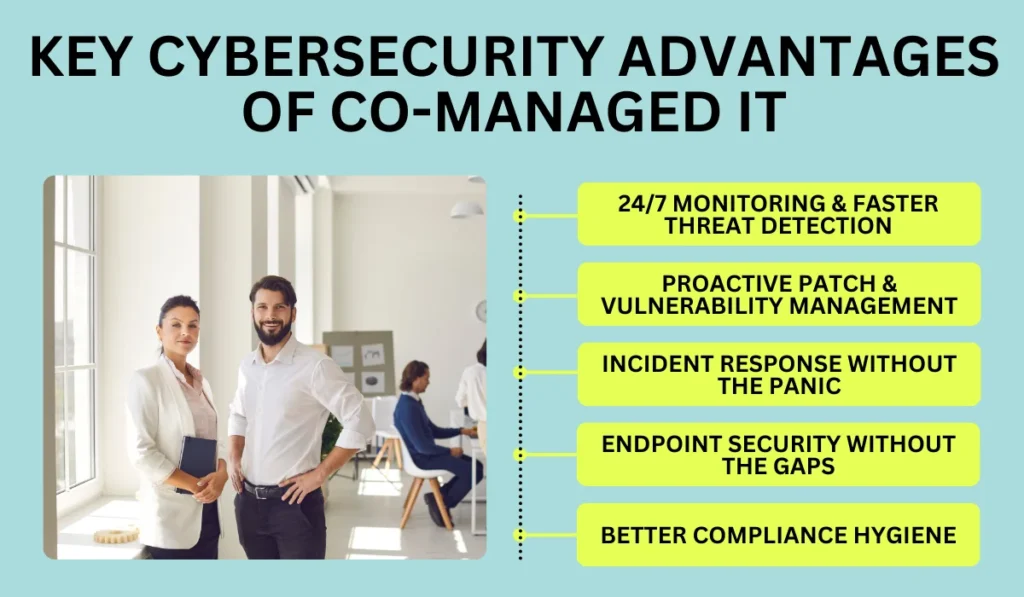Managed Service Provider
The Best Managed IT Service Providers in San Ramon
Rebecca Lamanna

With cyberattacks on the rise and IT costs climbing, small and mid-sized businesses face growing pressure to stay secure. Managed IT is a “cybersecurity magic bullet hiding in plain sight” as organizations seek more innovative ways to fortify their digital defenses without overspending.
Co-managed IT services offer an ideal solution for overburdened internal IT teams. They streamline day-to-day IT operations, strengthen cybersecurity, and provide the cost efficiency and scalability modern businesses need to keep up with evolving demands.
With access to proven strategies for disaster recovery, proactive monitoring, and robust IT management, co-managed IT bridges the gap between internal limitations and external security threats. It’s a cost-effective way to reduce risk, improve resilience, and keep your IT strategy aligned with business goals.
Whether you need to reduce downtime, upgrade firewalls, or ease help desk strain, co-managed IT gives you expert support without giving up control. It’s a more innovative way to protect your resources and support secure growth.
As your organization scales, your IT needs will evolve quickly. What once felt manageable with a small team and basic tools becomes far more complex when remote access, customer data, and compliance frameworks enter the picture. The result? Increased exposure to cybersecurity threats that can escalate quickly.
Small and mid-sized businesses are especially attractive to bad actors because they often have valuable data but fewer security resources than large enterprises, making them easier targets. A recent GlobeNewswire report found that 94% of SMBs experienced at least one cyberattack in 2024, up from 64% in 2019. These numbers are a wake-up call.
When growth outpaces your internal capacity, DIY IT support creates blind spots in:
Even a solid internal IT department can get overwhelmed, mainly when it’s focused on daily operations. That’s where co-managed IT makes the most significant impact.
By teaming up with a managed IT provider, you gain strategic support that enhances your cybersecurity posture, streamlines risk mitigation, and helps you reduce costs by eliminating the need for extra staff or expensive tools..
With fewer vulnerabilities, more transparent accountability, and a stronger foundation for future expansion, co-managed IT doesn’t just plug gaps.
As cyber threats continue to evolve, how can your team keep up without stretching your in-house staff or overloading your existing resources? That’s where co-managed IT services enter the picture, not as a replacement, but as a force multiplier.
In a co-managed model, your in-house IT team stays in the driver’s seat, managing core IT operations and aligning strategy with business goals. Meanwhile, a trusted Managed Service Provider (MSP) steps in as a strategic ally to handle the heavy lifting that your team doesn’t have time, or sometimes the specialized skills, to address.
Here’s how that division of labor typically works:
This shared responsibility model creates a seamless partnership that strengthens your organization’s overall security posture. Rather than stretching your team thin, you get expert eyes and hands focused on today’s most pressing cyber threats.
By blending internal knowledge with external expertise, co-managed IT helps you modernize your IT infrastructure without losing control. The outcome? A secure, scalable, and efficient environment where every tool and team member is working in sync.
With co-managed IT, you’re not just filling gaps; you’re empowering your internal team to do more of what they do best, backed by a partnership designed to help you thrive.
Here’s how co-managed IT stacks up against the traditional in-house approach:
| Feature/Responsibility | Traditional In-House IT | Co-Managed IT |
|---|---|---|
| Team Capacity | Limited by internal staffing and workload | Scales easily with external expertise and tools |
| 24/7 Monitoring | Often unavailable outside business hours | Around-the-clock threat detection and response |
| Security Updates & Patch Management | May be delayed due to limited bandwidth | Handled proactively and consistently |
| Incident Response | Reactive; may lack specialized playbooks | Structured, rapid response with expert guidance |
| Endpoint Security | Inconsistent across devices or locations | Uniform, policy-driven deployment across all endpoints |
| Compliance Support | Can be time-consuming and resource-heavy | Supported with documentation, audits, and regulatory frameworks |
| IT Strategy Alignment | Focused on operations; strategic growth may be secondary | Joint planning with MSP to support long-term business goals |
| Scalability | Difficult without hiring more staff | Flexible and scalable without increasing payroll |
| End-User Support | Limited by staffing and available hours | Scalable help desk and service desk support, available as needed |

Once you understand the shared responsibilities in a co-managed IT model, the next logical question is: What specific security benefits does this bring to your organization? Below are five impactful advantages that directly support your ability to stay secure, responsive, and resilient in a rapidly evolving threat landscape.
Cyber threats don’t clock out when your team does. Unfortunately, many internal IT teams aren’t equipped for around-the-clock threat detection, leaving your systems vulnerable outside business hours.
A co-managed IT support provider extends your team’s reach with:
According to IBM’s 2025 Cost of a Data Breach Report, the global average cost of a breach dropped by nearly 9% to $4.44 million, down from $4.88 million in 2024, a decline attributed mainly to faster threat identification and containment.
However, in the U.S., the average breach cost remains significantly higher at $10.22 million. This underscores the critical need for proactive security measures.
With co-managed IT, you can strengthen your defensive posture and accelerate threat response, all without overloading your internal IT team.
Delayed patching is one of the most common security gaps, usually caused by bandwidth or prioritization issues. When your internal IT staff is stretched thin, it can miss patches due to bandwidth issues..
A co-managed IT approach solves this by:
This results in a consistent patching cadence, significantly reducing exposure to known vulnerabilities. It also protects your IT infrastructure without pulling time away from strategic initiatives.
During a breach, speed is everything. A well-coordinated response can mean the difference between a minor disruption and a full-blown crisis.
With a co-managed model, you benefit from:
Instead of reactive scrambling, your incident response becomes a well-practiced routine, reducing stress, limiting damage, and preserving business continuity. This is how modern organizations turn cyber threats into recoverable events.
In hybrid environments, endpoints are everywhere, and they’re one of the most common entry points for attackers. Every device, from laptops to mobile phones, is a potential vulnerability.
A co-managed IT strategy ensures:
This uniform approach closes the security gaps that often arise when in-house staff lack the time or tools to track every device. The result is a scalable, repeatable endpoint strategy that grows with your team and tech stack.
Meeting regulatory requirements, especially across frameworks like HIPAA, SOC 2, and NIST, requires precision, documentation, and accountability. And when your internal team is focused on daily tasks, compliance can become an afterthought.
Here’s how co-managed IT strengthens your compliance readiness:
The Cyber Readiness Institute found that many SMBs struggle with basic compliance due to limited resources and awareness. Co-managed services give you the lift needed to clear audits and reduce your exposure to costly fines.
Ultimately, each of these five advantages helps you defend your business more proactively, maximize your existing IT resources, and stay ahead of evolving cyber threats, all without overwhelming your core team.
You’ve seen the advantages of co-managed IT from a strategic level; now, here’s how Parachute brings that vision to life. We don’t just support your internal team; we integrate with it to deliver practical, measurable cybersecurity improvements.
At Parachute, co-managed doesn’t mean handing over the reins. It means sitting at the same table, working with a partner who understands your IT environment, your goals, and your security standards.
Our co-managed cybersecurity approach includes:
Everything we do is designed to protect your data, expand your team’s capabilities, and build confidence in your technology investments.
We believe in transparency, partnership, and trust. When you work with Parachute, you don’t just get support, you gain a cybersecurity ally that helps you grow securely, on your terms.
Schedule your consultation with Parachute today. I’ll help you build a co-managed IT solution that protects your business and powers your future.
Co-managed IT enhances your internal team’s efforts by filling gaps, not taking over. Your staff focuses on strategy and daily tasks, while the provider handles 24/7 monitoring, patching, and threat response. You stay in control while gaining expert-level support.
It helps fix common issues like delayed patching, lack of 24/7 threat detection, unsecured endpoints, and compliance gaps. Co-managed IT adds structure and automation so your team can shift from reactive to proactive security.
Yes. It supports audit prep by creating documentation, conducting risk assessments, and aligning controls with frameworks like HIPAA, SOC 2, and NIST. This keeps you audit-ready without overloading your internal team.